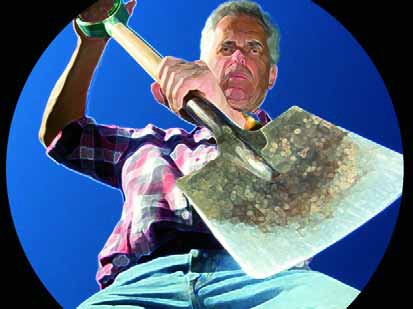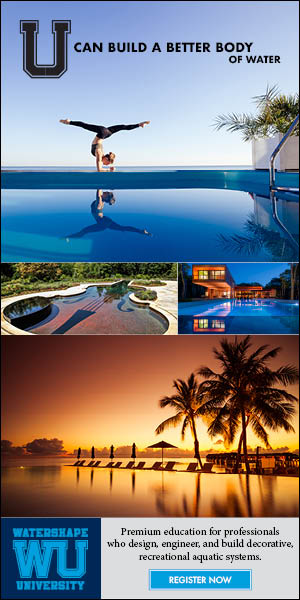Pools & Spas
In last month's introduction to what it takes to prepare for, organize and complete the excavation stage of the watershape-construction process, basic common sense was the governing factor in how the process should proceed. What I was discussing last time, however, was simple, flat-site excavations - cases in which access is commonly not an issue, soils are often consistent across a site and the potential surprises are relatively few. This time, my focus is an altogether different breed of excavations - that is, the task of preparing a sloping, hillside site for installation of a watershape. This process offers
In last month's introduction to what it takes to prepare for, organize and complete the excavation stage of the watershape-construction process, basic common sense was the governing factor in how the process should proceed. What I was discussing last time, however, was simple, flat-site excavations - cases in which access is commonly not an issue, soils are often consistent across a site and the potential surprises are relatively few. This time, my focus is an altogether different breed of excavations - that is, the task of preparing a sloping, hillside site for installation of a watershape. This process offers
I like to tell people that I have the greatest job in the world. It's true, and whenever I start working with a new client, I feel like a kid in a candy store. Look at it this way: As a watershaper, I get paid to use my ideas, experience, imagination and creativity to make my clients' dreams come true. Essentially, we're big kids playing with very big toys, and clients respond to our enthusiasm in a big way. And the best thing about it is that exterior designs are like fingerprints: Each one is different; every client has his or her own set of priorities; and every property calls for a
I like to tell people that I have the greatest job in the world. It's true, and whenever I start working with a new client, I feel like a kid in a candy store. Look at it this way: As a watershaper, I get paid to use my ideas, experience, imagination and creativity to make my clients' dreams come true. Essentially, we're big kids playing with very big toys, and clients respond to our enthusiasm in a big way. And the best thing about it is that exterior designs are like fingerprints: Each one is different; every client has his or her own set of priorities; and every property calls for a
One would like to think that if there was anything all watershapers were good at doing, it would be digging holes. As with many other watershaping activities, however, it is apparent that some are better at it than others and that the excavation portion of a project either does a good job of setting the stage for great things to follow - or involves errors that can project themselves all the way through to the finished product. In my view, getting things right at this stage is as important as any other step in the design, engineering or construction process and is actually
One would like to think that if there was anything all watershapers were good at doing, it would be digging holes. As with many other watershaping activities, however, it is apparent that some are better at it than others and that the excavation portion of a project either does a good job of setting the stage for great things to follow - or involves errors that can project themselves all the way through to the finished product. In my view, getting things right at this stage is as important as any other step in the design, engineering or construction process and is actually
I've seen many changes in the 38 years I've been installing vinyl-liner pools. When I started out, we worked mostly with wooden walls, and I even recall some made with asbestos. We always did our best, but I'll concede that in those early days the construction techniques were relatively unsophisticated. These days, we at The Pool & Spa Doctor (Wall, N.J.) work mostly with galvanized-steel construction and, in a smaller percentage of projects, with either modular polymer or fiberglass systems. We've been at it long enough in our market that, through the years, we've gone in and replaced many of the old wooden walls with modern modular systems - an experience that always drives home for us the fact that the
I've seen many changes in the 38 years I've been installing vinyl-liner pools. When I started out, we worked mostly with wooden walls, and I even recall some made with asbestos. We always did our best, but I'll concede that in those early days the construction techniques were relatively unsophisticated. These days, we at The Pool & Spa Doctor (Wall, N.J.) work mostly with galvanized-steel construction and, in a smaller percentage of projects, with either modular polymer or fiberglass systems. We've been at it long enough in our market that, through the years, we've gone in and replaced many of the old wooden walls with modern modular systems - an experience that always drives home for us the fact that the
The design and installation of the circulation, filtration and chemical-treatment systems for the pools at St. Lucia's Jade Mountain was a task of monumental proportions and extreme technical, physical and logistical difficulty. The effort was spearheaded by watershaper/hydraulics expert Chris Barnes, who spent months on site installing precision systems engineered to provide years of nearly maintenance-free service. Installing the circulation systems for the pools at Jade Mountain was a challenge unlike any other. I was first approached about the project by my good friend, Skip Phillips, who explained that he had already been working on the project's design for several years and indicated that it was going to be something truly amazing. He observed that the owner and his design team didn't have anyone in place with any experience with the installation of extremely complex watershapes and suggested that I might be the one to step up to the challenge and keep


















